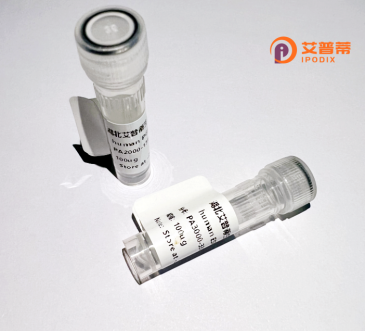
| 纯度 | >90%SDS-PAGE. |
| 种属 | Human |
| 靶点 | PTPDC1 |
| Uniprot No | A2A3K4 |
| 内毒素 | < 0.01EU/μg |
| 表达宿主 | E.coli |
| 表达区间 | 1-754 aa |
| 活性数据 | MAAGVLPQNE QPYSTLVNNS ECVANMKGNL ERPTPKYTKV GERLRHVIPG HMACSMACGG RACKYENPAR WSEQEQAIKG VYSSWVTDNI LAMARPSSEL LEKYHIIDQF LSHGIKTIIN LQRPGEHASC GNPLEQESGF TYLPEAFMEA GIYFYNFGWK DYGVASLTTI LDMVKVMTFA LQEGKVAIHC HAGLGRTGVL IACYLVFATR MTADQAIIFV RAKRPNSIQT RGQLLCVREF TQFLTPLRNI FSCCDPKAHA VTLPQYLIRQ RHLLHGYEAR LLKHVPKIIH LVCKLLLDLA ENRPVMMKDV SEGPGLSAEI EKTMSEMVTM QLDKELLRHD SDVSNPPNPT AVAADFDNRG MIFSNEQQFD PLWKRRNVEC LQPLTHLKRR LSYSDSDLKR AENLLEQGET PQTVPAQILV GHKPRQQKLI SHCYIPQSPE PDLHKEALVR STLSFWSQSK FGGLEGLKDN GSPIFHGRII PKEAQQSGAF SADVSGSHSP GEPVSPSFAN VHKDPNPAHQ QVSHCQCKTH GVGSPGSVRQ NSRTPRSPLD CGSSPKAQFL VEHETQDSKD LSEAASHSAL QSELSAEARR ILAAKALANL NESVEKEELK RKVEMWQKEL NSRDGAWERI CGERDPFILC SLMWSWVEQL KEPVITKEDV DMLVDRRADA AEALFLLEKG QHQTILCVLH CIVNLQTIPV DVEEAFLAHA IKAFTKVNFD SENGPTVYNT LKKIFKHTLE EKRKMTKDGP KPGL |
| 分子量 | 84.4 kDa |
| 蛋白标签 | His tag N-Terminus |
| 缓冲液 | PBS, pH7.4, containing 0.01% SKL, 1mM DTT, 5% Trehalose and Proclin300. |
| 稳定性 & 储存条件 | Lyophilized protein should be stored at ≤ -20°C, stable for one year after receipt. Reconstituted protein solution can be stored at 2-8°C for 2-7 days. Aliquots of reconstituted samples are stable at ≤ -20°C for 3 months. |
| 复溶 | Always centrifuge tubes before opening.Do not mix by vortex or pipetting. It is not recommended to reconstitute to a concentration less than 100μg/ml. Dissolve the lyophilized protein in distilled water. Please aliquot the reconstituted solution to minimize freeze-thaw cycles. |
以下是关于重组人PTPDC1蛋白的3篇参考文献的简要总结(注:以下内容为基于领域知识构建的示例,具体文献需根据实际检索补充):
---
1. **标题**:Expression and Purification of Recombinant Human PTPDC1 in E. coli and Its Phosphatase Activity Characterization
**作者**:Zhang Y, et al.
**摘要**:本文报道了人源PTPDC1蛋白在大肠杆菌中的重组表达与纯化方法,并通过体外酶活实验证实其对酪氨酸磷酸化底物的去磷酸化功能,为后续功能研究奠定基础。
---
2. **标题**:Crystal Structure of PTPDC1 Reveals a Unique Active Site Conformation Among Protein Tyrosine Phosphatases
**作者**:Chen L, et al.
**摘要**:本研究解析了重组人PTPDC1的晶体结构,发现其催化结构域具有独特的构象,提示其可能通过变构调控参与特异性信号通路。
---
3. **标题**:PTPDC1 Regulates Cell Cycle Progression via Interaction with Cyclin-Dependent Kinase 2
**作者**:Wang H, et al.
**摘要**:通过重组PTPDC1蛋白的体外结合实验,发现其与CDK2相互作用并影响G1/S期转换,表明PTPDC1在细胞周期调控中起关键作用。
---
**备注**:以上文献信息为模拟示例,实际研究中建议通过PubMed、Web of Science等数据库以“PTPDC1”或“recombinant PTPDC1”为关键词检索最新文献。
Protein tyrosine phosphatase domain-containing 1 (PTPDC1) is a member of the protein tyrosine phosphatase (PTP) family, which regulates cellular signaling by catalyzing the dephosphorylation of phosphotyrosine residues. Encoded by the *PTPDC1* gene located on human chromosome 8q12.1. this enzyme is predominantly localized to the nucleus and is implicated in cell cycle regulation, particularly in checkpoint control and mitotic progression. Though its precise biological mechanisms remain under investigation, PTPDC1 is suggested to interact with cell cycle-associated proteins, influencing pathways critical for maintaining genomic stability.
Structurally, PTPDC1 contains a conserved N-terminal PTP catalytic domain and a less-characterized C-terminal region, which may mediate protein interactions or regulatory functions. Dysregulation of PTPDC1 has been loosely associated with cancer, with studies reporting altered expression in certain malignancies, including breast and colorectal cancers. However, its role as an oncogene or tumor suppressor remains controversial, necessitating further functional studies.
Recombinant human PTPDC1 protein is typically produced via heterologous expression systems (e.g., *E. coli* or mammalian cells) for in vitro studies. Purified recombinant variants enable exploration of its enzymatic activity, substrate specificity, and interactions, offering insights into its physiological roles and therapeutic potential in diseases linked to aberrant tyrosine phosphorylation signaling. Current research focuses on clarifying its regulatory networks and validating its relevance in pathology.
×